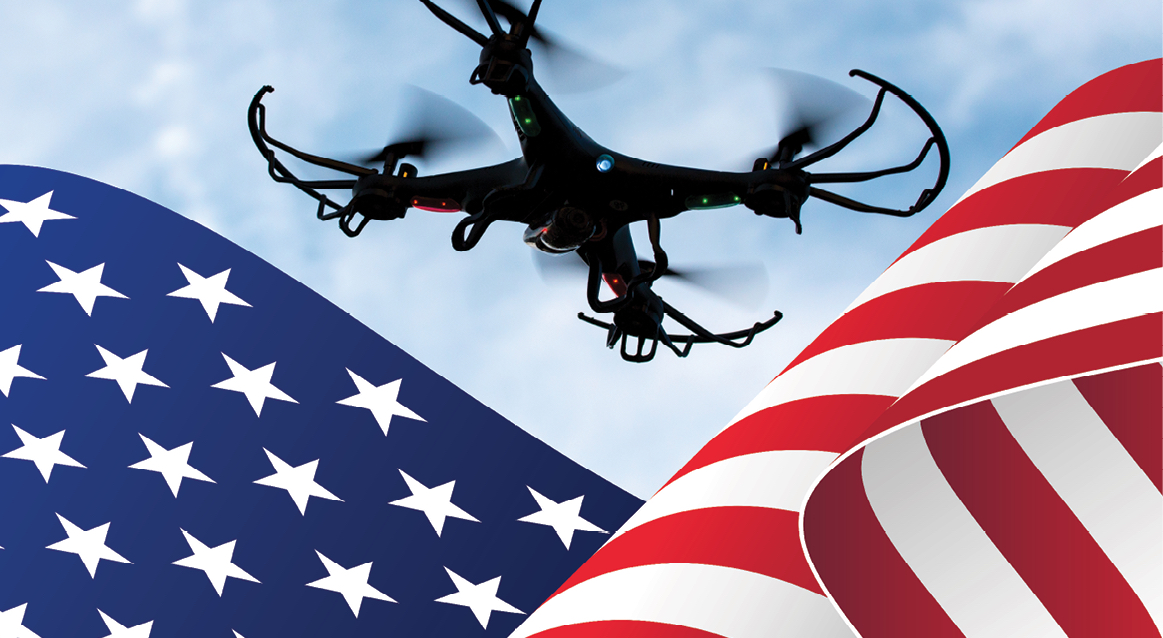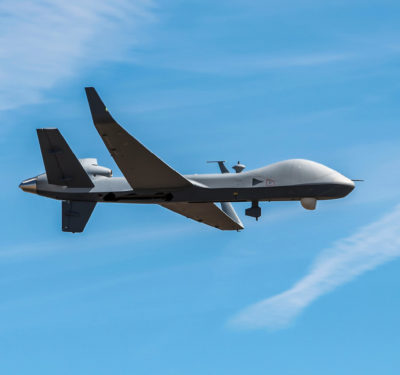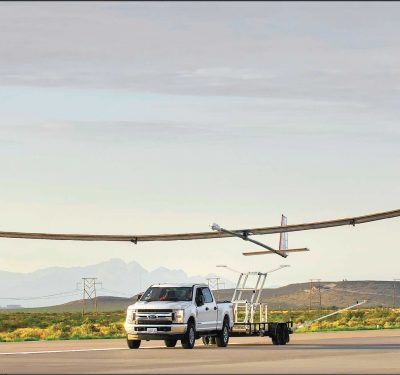
Congress did a fantastic, bi-partisan job on the technically challenging topic of drones last month when it passed the 2018 Federal Aviation Administration (FAA) Reauthorization Act. And when I say “bipartisan” I mean it. The Act passed 393 to 13 in the House and 93 to six in the Senate. That’s a 97 percent and 94 percent vote margin in each house, respectively. Wow.
What makes this bill even more amazing is that it passed despite determined opposition and even addressed touchy policy areas like privacy, drone registration and counter drone authorities. I’m sure you’ve read lots of articles on what the act contained. I’m also going to tell you why the act contained what it did, who supported the provision and who lost out. It’s a big piece of legislation with lots of interesting stuff in it but I’ll only address the unmanned aircraft systems (UAS) portion of the act. I’ll organize my commentary by section so you can reference language of the bill itself. I can’t cover everything in the Act, but I’ll hit the highlights.
THE FAA REAUTHORIZATION ACT OF 2018
The Act funds the FAA for a full five years, just like the federal government is SUPPOSED to fund federal agencies.
THE ISSUES: Congress had been funding the FAA year to year, largely due to disputes over privatizing portions of the FAA. The pro-privatization crowd was hoping President Trump would take their side, but he didn’t. This forced the privatizers to give up and support a normal, five-year funding bill.
THE WINNERS: The FAA.
THE LOSERS: Supporters of FAA privatization.
SEC. 342. UPDATE OF FAA COMPREHENSIVE PLAN
FAA must update Congress on their plan for integrating UAS into the National Airspace System (NAS) within 270 days. It must include: the possibility of using an Unmanned Traffic Management (UTM) system, roles/responsibilities/authorities of government and the private sector to report rogue drones, methods to distinguish between lawful/unlawful UAS and ways to mitigate risks of unlawful UAS. The FAA has 90 days to report to Congress on their strategy to implement the Low Altitude Authorization and Notification Capability (LAANC), the Integration Pilot Program (IPP) and the UTM Pilot Program (UPP).
THE ISSUES: This is the start of a concerted congressional effort to nail down the FAA on when the nation can expect full drone integration into the NAS and the executive branch can start defending the nation from rogue drones. Congress wants a written plan to hold the FAA accountable and they certainly didn’t give the FAA at lot of time to write that plan.
THE WINNERS: The commercial drone lobby, UTM providers, the Department of Homeland Security (DHS) and NASA. The commercial drone lobby and UTM providers want as much specificity as possible, along with an FAA written commitment to UTM. DHS wins because it gets details on the FAA’s counter UAS plans and NASA wins because they are big UTM supporters.
THE LOSERS: No one, really. There are some UTM nay-sayers in the FAA that won’t like the UTM language and generally no federal agency likes to have its hands tied with a formal plan, but most of the FAA supports the plan.
SEC. 44803. UNMANNED AIRCRAFT TEST RANGES
UAS test ranges can get funding from sources other than FAA and the FAA has Other Transactional Authority (OTA) for UAS research. Test sites are extended for another five years. The FAA must use its ASSURE research consortium to the maximum extent possible.
THE ISSUES: This is the test site and ASSURE states banding together to extend their programs, get more flexible funding sources and force the FAA to use their facilities. Before this language, the FAA had resisted accepting other federal agency funding for research. To be fair, most of the resistance was in the early days and the FAA is much more flexible now. An FAA UAS OTA is a great idea, but Congress had to authorize it. OTAs allow their members to do prototype or limited production work without going through the FAR (Federal Acquisition Regulations).
THE WINNERS: The UAS Test Site and ASSURE states (AK, AL, CA, FL, HI, KS, LA, MA, MD, MI, MS, MT, NC, ND, NJ, NM, NV, NY, OH, OR, PA, TX and VA). That’s a lot of states that will always get their way in Congress if they stick together. NASA, DHS and the Departments of Defense and Interior (DOD and DOI) benefit also because they can use the test sites directly, no questions asked and participate in the FAA UAS Research OTA.
THE LOSERS: The FAA Technical Center. The Tech Center already knew the test sites and ASSURE would get a lot of research money, but the act codifies it.
SEC. 44805. SMALL UNMANNED AIRCRAFT SAFETY STANDARDS
Small UAS (sUAS) will have risk-based consensus safety standards approved by FAA. No airworthiness certificate and no type certification required for sUAS. ASSURE will set up a center to study standards.
THE ISSUES: I am not sure why this one is in here. The FAA is already on board with risk-based consensus safety standards and doing away with airworthiness/type certifications for sUAS. Maybe sUAS manufacturers wanted that in law? There was some talk of type certifications for classes of operations beyond Part 107 (beyond-line-of-sight flights, operations over people, etc.) but it wasn’t serious. ASSURE made sure it got in to study the consensus standards.
THE WINNERS: ASSURE and sUAS manufacturers.
THE LOSERS: No one. Everyone agreed on this issue.
SEC. 364. U.S. COUNTER-UAS (C-UAS) SYSTEM REVIEW OF INTERAGENCY COORDINATION PROCESSES
FAA has 60 days to start reviewing and 180 days to deliver a report on how the Administration coordinates C-UAS activity and what standards are used to protect the NAS, people and property from rogue UAS without interfering with the avionics of legally operating aircraft or air traffic control systems. The report must state how the administration assesses C-UAS system standards, how the interagency process works for C-UAS and whether the administration needs additional C-UAS authorities.
THE ISSUES: This is the start of a cavalcade of counter UAS support. Congress is dead serious about getting a working counter UAS system in this country and they’re making sure the administration knows it. I hope the FAA takes advantage of this report to state exactly what they need to defend the NAS from rogue drones.
THE WINNERS: C-UAS UAS systems manufacturers, DHS, Department of Justice (DOJ) and FAA. The commercial drone lobby also supports increased counter UAS authorities because they, too, want remote ID for everyone and view C-UAS UAS as a forcing issue.
THE LOSERS: The terrorists and a small group of drone users who think the feds will use increased counter UAS authorities to restrict consumer drone activity.
SEC. 366. STRATEGY FOR RESPONDING TO PUBLIC SAFETY THREATS AND ENFORCEMENT UTILITY OF UNMANNED AIRCRAFT SYSTEMS
FAA has one year to develop a comprehensive strategy that provides guidance to state and local authorities on how to respond to public safety threats from drones and how to use drones to enhance the effectiveness of first responders. The FAA has 180 days to put this info on a website.
THE ISSUES: A congressional reminder that the feds must team with their state, local and tribal partners in the C-UAS battle. There is no such thing as an Air Police Force for the FAA and the FAA can never hope to counter all drone public safety threats across the nation; they need help from local law enforcement. Good to see Congress knows too.
THE WINNERS: State, local and tribal law enforcement and common sense.
THE LOSERS: No one.
SEC. 44810. AIRPORT SAFETY AND AIRSPACE HAZARD MITIGATION AND ENFORCEMENT
The FAA must develop a plan to certify, permit and authorize C-UAS systems. The FAA must set up an aviation rulemaking committee (ARC) to make recommendations and test C-UAS at five airports, including one top 10 passenger boarding airport. Airport sponsors can buy certified counter UAS systems using the Airports Improvement Program funding (AIP). The plan cannot delegate C-UAS authority to other federal, state, local, territorial, or tribal agencies, or an airport sponsor.
The Aircraft Sabotage Act, the Computer Fraud and Abuse Act of 1986, the Wiretap Act and the Pen/Trap Statute, shall not apply to FAA counter UAS activities.
THE ISSUES: I had to take a knee after reading this section. It has everything the FAA needs to launch an effective C-UAS system to protect our nation’s airports. Allowing airport sponsors to use AIP to buy C-UAS is a huge advancement and provides airports a solid C-UAS funding mechanism for C-UAS. The biggest thing in this section—drum roll please—gives the FAA authority to jam drone data links, shoot down rogue drones, hack into their systems and locate drones via their cellular communications. Wow.
The only thing I don’t agree with in the provision is they can’t delegate authority to local authorities. It makes sense not to delegate to locals if we’re just talking about airport and controlled airspace C-UAS operations. I’m assuming critical infrastructure C-UAS will fall to DHS, where some delegation to local, or even commercial, authorities make sense. States’ lists of critical infrastructure will always differ from the federal list and states should be authorized to defend infrastructure, gatherings or personnel they deem important. Although the feds genuinely like the governor of Texas, they will never take his safety as seriously as the Texas Rangers. It’s the same for state courthouses, judges, prisons, state police locations, etc. There’s lots of state stuff to defend that the feds can never get to.
THE WINNERS: See previous section, plus the “one top 10 passenger boarding airport” that had their Congressional delegation insert that specific language (my bet is Miami…).
THE LOSERS: See previous section and possibly add state, local and tribal governments.
SEC. 44808. CARRIAGE OF PROPERTY BY SUAS FOR COMPENSATION OR HIRE
FAA has one year to authorize carriage of property by operators of commercial sUAS.
THE ISSUES: Dude, we’re getting drone package delivery! This was a hard-fought rule for the commercial drone lobby. They got what they wanted here—the FAA has a year to consult with the proper people, make a comprehensive plan and APPROVE drone cargo carriage. One year. Wow.
THE WINNERS: The commercial drone lobby, specifically Amazon and Walmart. People (like me) who want their packages in less than an hour.
THE LOSERS: The poor folks at the FAA who have a year to make this happen.
SEC. 44809. EXCEPTION FOR LIMITED RECREATIONAL OPERATIONS OF UNMANNED AIRCRAFT
UAS hobbyists must register their drones and the FAA can mandate equipage for safety/NAS integration, remote ID and procedures on avoiding risks to aviation safety or critical infrastructure. Hobbyists can fly UAS in Class B, C, D or E airspace from FAA-approved fixed sites.
THE ISSUES: This is a big one for C-UAS and the commercial drone lobby. Drone scofflaws had been using rules intended to protect model aircraft enthusiasts from FAA over-regulation to avoid registering their drones or getting required training. The Academy of Model Aeronautics (AMA), supported by some consumer drone manufacturers, fought this law but lost out to a united front of federal drone regulators (FAA, DHS, DOJ, DOD) and the commercial drone lobby. This section gets drone hobby use back to the way the FAA has traditionally treated model aircraft flown by legitimate model aircraft organizations. It makes it clear the FAA can mandate registration, remote ID and markings but throws a bone to the AMA by allowing hobbyist flight at FAA-approved sites, even if they’re in Class B, C, D or E airspace.
THE WINNERS: FAA, DHS, DOJ, DOS and the commercial drone lobby.
THE LOSERS: The AMA and a few consumer drone manufacturers who fought this section under the table because it might impact drone sales.
SEC. 351. UNMANNED AIRCRAFT SYSTEMS INTEGRATION PILOT PROGRAM (IPP)
The IPP now has its own law and three years to complete its mission.
THE ISSUES: The IPP was always a White House program without the force of law. This makes the IPP a law, but puts a limit on how long the IPP has to work a long list of tasks (BLOS, operations over people, state/local/tribal roles in drone regulation, zoning impacts, etc.)
THE WINNERS: The IPP states and FAA (the IPP now has a limited life span and won’t interfere with rule making indefinitely.)
THE LOSERS: People who saw IPP as extending the rule making process by drawing resources from the FAA.
SEC. 352. PART 107 TRANSPARENCY AND TECHNOLOGY IMPROVEMENTS
FAA has 30 days to publish a sample of the safety justifications for approved sUAS waivers and airspace authorizations (they cannot reveal proprietary or commercially sensitive information). FAA also must provide real time confirmation that an online waiver request has been received by the FAA and must provide applicants the status of their application.
THE ISSUE: I know what you’re thinking: “Surely Congress didn’t have to make a law to tell the FAA to do this?” But yes, yes they did. FAA culture is well known for its “bring me a rock” approach to aviation waivers (i.e. you can never bring the right rock and they won’t tell you which one to bring). I never knew why they did that, but the process got out of control when the FAA went from dealing with a few dozen airlines and a handful of manned aircraft manufacturers to thousands of drone companies. I’m still pessimistic on getting the FAA to open up. Note: they can use propriety information as an excuse to withhold data.
THE WINNERS: The commercial drone lobby, tens of thousands of drone small businesses.
THE LOSERS: FAA culture.
SEC. 358. UAS PRIVACY REVIEW
The Comptroller General (CG) of the United States has 180 days to review the privacy issues associated with UAS operating in the NAS.
THE ISSUES: Drone privacy is a political hot potato impeding drone rulemaking progress. The FAA rightfully argued they do aviation safety, not privacy. DOJ was my favorite to lead a study, but Congress gave it to the CG because the Government Accountability Office works for him and they do big, cross-agency reports for a living. The CG is, by law, independent from the other executive departments so they aren’t pressured to present the view of a particular Cabinet member.
THE WINNERS: The FAA (big bullet dodged).
THE LOSERS: The Comptroller General. (Don’t let that potato burn you!)
SEC. 360. STUDY ON FINANCING OF UNMANNED AIRCRAFT SERVICES
The CG has 180 days to study how to recover UAS regulatory costs and payment for air navigation services.
THE ISSUES: In an Act with a lot of massive improvements, this might be the biggest. This will help derive a cost model for the UTM industry and finally allow the FAA to hire enough experts to get drone waivers and rules moving at the speed of business. The FAA was always comfortable with a fee for service UTM system, but had been dancing around the issue of using fees to recover staff costs. This settles the issue and hopefully gets drone regulation on the fast track with more FAA manpower.
THE WINNERS: FAA (bigly), the UTM industry.
THE LOSERS: Smaller drone operators (although I hope not) and the Comptroller General (this is a BIG task.)
SEC. 372. UAS SAFETY ENFORCEMENT
FAA must establish a five-year remote ID pilot program and figure out how to help federal, state and local law enforcement detect drones operating illegally. They shall establish a pilot program to use remote ID for safety oversight of UAS that are not in compliance with federal aviation laws.
THE ISSUES: The FAA hasn’t released anything on remote ID, despite working the issue for nearly two years after DOD and DHS refused to coordinate on further drone rules until the FAA mandated remote ID. In the FAA’s defense, they could only offer a partial solution because they couldn’t force hobbyists to carry remote ID until Section 44809 removed this obstacle. Remote ID is the cornerstone to C-UAS, large scale commercial drone usage and drone privacy.
THE WINNERS: FAA, DOD, DHS, DOJ, drone privacy advocates and the commercial drone lobby. They’ve been after this issue for years and putting their lobbying/congressional education where their interests are certainly worked.
THE LOSERS: Hobbyists and a few consumer drone manufacturers that feared remote ID would stifle sales.
SEC. 373. FEDERAL AND LOCAL AUTHORITIES
The CG has 180 days to study and report on the roles of federal, state, local and tribal governments in the regulation and oversight of low-altitude drone operations in the NAS. The report must address gaps in federal, state, local and tribal authorities, how much regulatory consistency is needed, and the infrastructure needed to monitor/enforce drone laws.
THE ISSUES: The CG takes on another big drone issue—which makes you think Congress doesn’t trust the FAA to move on some thorny issues. The IPP is supposed to be collecting data on how the feds and locals should work together, but it sounds like the CG will set the tone on drone privacy with this report. The commercial UAS lobby wants to limit the role of local authorities in drone regulation, but I think this study will show that’s unrealistic. Local manpower will be necessary to enforce regulations on drones, which are far more numerous than manned aircraft and can take off from and land anywhere.
THE WINNERS: The FAA. They dodged another “no win” study.
THE LOSERS: Maybe the IPP. This report could steal their thunder. The commercial drone lobby also is watching this closely, in case the report gives locals more regulatory leeway. They don’t want “patchwork” drone laws that differ from state to state.
SEC. 374. SPECTRUM
The FAA, National Telecommunications and Information Administration and the Federal Communications Commission have 270 days to report on whether drones can operate on specific C or L band frequencies. If not, they must recommend alternate frequencies.
THE ISSUES: This section brought a tear to my eye. Congress actually cares about drone spectrum! Any drone expert worth her salt knows drone data link spectrum is a massive concern. Military drones are fine because they have plenty of spectrum allocated, but nearly all useable civilian spectrum has gone to the cell phone companies. The problem with relying on cell phone spectrum for drone command and control (C2) is users can’t afford dropped calls and drones should use aviation protected frequencies for C2 to ensure minimum interference with their data links. This study will say if C or L band can work for drone data links.
THE WINNERS: UAS manufacturers and prospective UAS BLOS operators.
THE LOSERS: The cell phone industry (if the study says C or L band are viable).
Overall, this is a breath-taking piece of legislation that should be a model for how to move forward on an extremely technical, disruptive technology. “Congress has given the Executive Branch everything it needs to make commercially-viable drone rules and to protect our nation from rogue drones.” Let’s see if the executive Branch can handle all this authority and put the United States back at the forefront of the race to make commercially viable drone rules.






